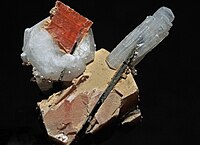
Photo from wikipedia
Abstract. Phosphorus (P) concentrations in sediments are frequently used to reconstruct past environmental conditions in freshwater and marine systems, with high values thought to be indicative of a high biological… Click to show full abstract
Abstract. Phosphorus (P) concentrations in sediments are frequently used to reconstruct past environmental conditions in freshwater and marine systems, with high values thought to be indicative of a high biological productivity. Recent studies suggest that the post-depositional formation of vivianite, an iron(II)-phosphate mineral, might significantly alter trends in P with sediment depth. To assess its importance, we investigate a sediment record from the Bornholm Basin that was retrieved during the Integrated Ocean Drilling Program (IODP) Baltic Sea Paleoenvironment Expedition 347 in 2013, consisting of lake sediments overlain by brackish–marine deposits. Combining bulk sediment geochemistry with microanalysis using scanning electron microscope energy dispersive spectroscopy (SEM-EDS) and synchrotron-based X-ray absorption spectroscopy (XAS), we demonstrate that vivianite-type minerals rich in manganese and magnesium are present in the lake deposits just below the transition to the brackish–marine sediments (at 11.5 to 12 m sediment depth). In this depth interval, phosphate that diffuses down from the organic-rich, brackish–marine sediments meets porewaters rich in dissolved iron in the lake sediments, resulting in the precipitation of iron(II) phosphate. Results from a reactive transport model suggest that the peak in iron(II) phosphate originally occurred at the lake–marine transition (9 to 10 m) and moved downwards due to changes in the depth of a sulfidization front. However, its current position relative to the lake–marine transition is stable as the vivianite-type minerals and active sulfidization fronts have been spatially separated over time. Experiments in which vivianite was subjected to sulfidic conditions demonstrate that incorporation of manganese or magnesium in vivianite does not affect its susceptibility to sulfide-induced dissolution. Our work highlights that post-depositional formation of iron(II) phosphates such as vivianite has the potential to strongly alter sedimentary P records particularly in systems that are subject to environmental perturbation, such as a change in primary productivity, which can be associated with a lake–marine transition.
Journal Title: Biogeosciences
Year Published: 2018
Link to full text (if available)
Share on Social Media: Sign Up to like & get
recommendations!